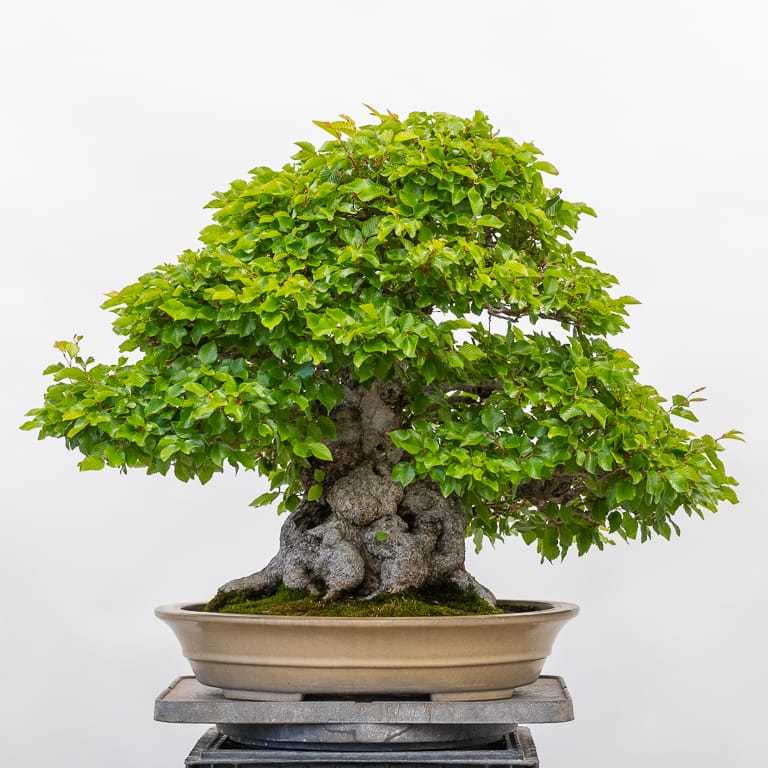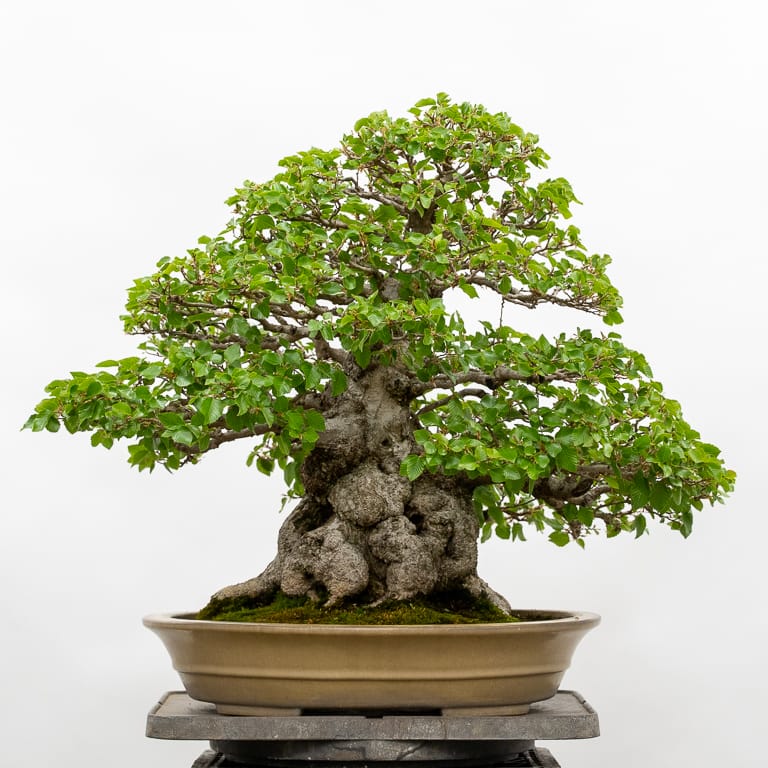I usually start thinking about pruning and partially defoliating Korean hornbeam in May. It’s around this time of year that the spring growth hardens off and shades out the interior branches which makes it a good time to prune.

Dense foliage on a Korean hornbeam – May 12, 2021
For the last few years, I partially defoliated this tree by removing most of the leaves from the outer branches. As a result, the tree has become less and less vigorous in spring.
Since the new growth was modest this year, I decided to keep more foliage than usual so I reduced new shoots to two leaves and only removed the largest leaves from crowded areas. The idea is that by preserving more foliage the tree doesn’t need to dip into its reserves as much this summer which should make the plant stronger through summer and fall.

After cutback – 18″
As trees mature, the work we do to maintain them may change along the way. Now that this tree only produces a modest amount of growth in spring, I don’t need to do as much work to keep new growth in check during the growing season.
I’ll decide how much to prune through summer and fall based on how much the tree grows in the coming months.
Subscribe to Bonsai Tonight
New Posts Delivered Every Tuesday and Friday
PASCAL ETEVENAUX says
Bonjour
Super article je possède un charme de Corée et je souhaiterais savoir si on peut le defolier totalement ?
Mon but et d’avoir du bourgeonnement arrière car les feuilles sont en bout de branche .
Merci beaucoup pour la réponse.
Pascal
Jonas Dupuich says
Great question Pascal. Full defoliation can work for hornbeam but it is stressful for the tree. If the tree is young and strong it may be a good option. If the tree is more refined partial defoliation is a less stressful alternative.
Here are two articles about defoliating this tree:
https://bonsaitonight.com/2012/07/17/defoliating-a-korean-hornbeam/
https://bonsaitonight.com/2012/07/20/defoliating-a-korean-hornbeam-part-2/
Adam says
Unfortunetely photos aren’t vissible in both parts of the article 🙁
Jonas Dupuich says
Thanks for the heads up – if you tell me more about what’s happening I’ll see what I can do.
Brian V says
Beautiful hornbeam, Jonas. You’ve done a fine job with this tree over the years.
Jonas Dupuich says
Thanks, Brian – I appreciate it!
Kyle Purvis says
Jonas, would the same technique apply for an American hornbeam? I have a collected tree that is entering refinement stage of development once I remove an air layer in about 60 days? Unfortunately my Korean hornbeam are not near as vigorous in my climate- the seem to be struggling no matter what I do?
Jonas Dupuich says
Hi Kyle – I did the same work on either an American or European hornbeam last night. I reduced the long shoots and then removed the large leaves to the point where light could reach the inner branches. Were the tree stronger I would have partially defoliated it.
If you’re preparing to remove a layer I’d want the tree to grow as strong as possible to stimulate root development and reduce the branches later.
As for sluggish Korean hornbeam, they grow well in a variety of climates so I can’t think of obvious reasons for the slowness beyond the basics of soil, water, sunlight, and fertilizer.
Jesse Strong says
My Korean hornbeam is almost identical to this. It could be it’s twin for sure. Where did you acquire yours? I wonder if they are actually related in some way. The resemblance is uncanny.
Jonas Dupuich says
The tree came from Matsunami-en in Oregon in the late 90s or early 2000s. I think they had a number of similar trees so there are likely cousins out there somewhere.
Jesse Strong says
Thanks! I’m absolutely sure my hornbeam came from the same place then. I acquired mine from an old Chinese man here in BC who had it for 20+ years. I had to do a lot of work to get it to the level trees like this should be at. It’s healthy and looking decent now. Still a ways to go but we’re on the right track. Seeing yours gets me stoked to continue, your tree looks great!
Anthony says
How do you manage foliage in a refined hornbeam like this in repotting years? I repotted a similar tree (that I’ve only owned for a few years) for this first time this year. I partially defoliated it last year and had a somewhat tepid second flush in August but had lots of buds to take into winter dormancy.
This year post repotting and root prune it has leafed out quite vigorously (similar to previous years) so, while I’m mindful of allowing it to recover strength and push energy into regrowing roots, I’m wondering whether I should consider partial defoliation again to allow light into the interior (where I have a few small branches in growing up to replace a couple of minor ones that have suffered winter die off)?
Jonas Dupuich says
Great question. Whether or not the tree was repotted, I’d want to let enough light into the tree’s interior to make sure the branches there stay healthy. If cutting back to two new leaves leaves the tree too dense, I’d try removing enough foliage to let more light through.
If it’s really strong (sending out long new shoots), I’d partially defoliate like normal. If the response after partial defoliating is often weak, I’d either fertilize more or try partially defoliating earlier in the season, or look to partially defoliate less frequently, if at all.